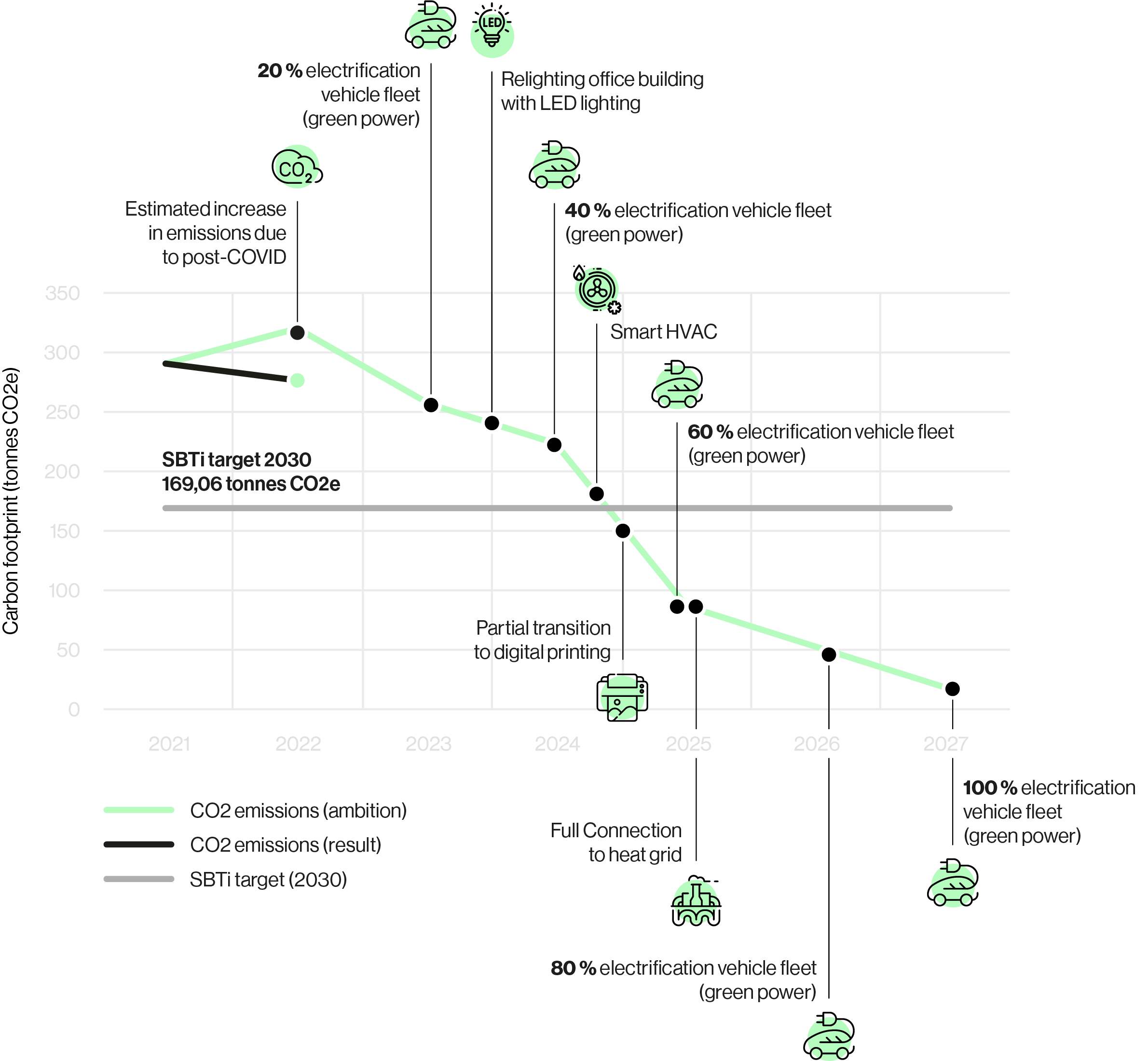NEWS
Another step closer to 0

As a publisher and printing company, die Keure, like any other business, has an impact on the environment. The exact nature of that impact is calculated and summarised in a figure that is symbolically called the ecological footprint. Thanks to an efficient sustainability strategy we are able to keep reducing that ecological footprint. Below we have set out the results of our sustainability efforts so far.
Since 2010 we have been making structural investments in sustainability and the environment in all stages of the production process. We evaluate our efforts on the basis of emissions expressed in CO2e (CO2 equivalents) in 3 different scopes1. With a CO2 equivalent footprint in scope 1 and 2 of less than 8g per € turnover – of which less than 0.2g per € CO2e energy use in 2022 – we can proudly call ourselves an industry leader.
Every year, die Keure has its CO2e footprint externally audited by our partner Encon. The results and action plans leading to a <1.5°C future for 2030 have been validated by the Science Based Targets initiative (SBTi).
How can we keep reducing our emissions?
To be in line with the Paris Climate Agreement, we must reduce our CO2 emissions by 42% by 2030. The goal we have set ourselves is slightly more ambitious: CO2 neutrality in scope 1 and 2 before 2030.
In 2021 the cumulative emissions still amounted to 291 tonnes of CO2e, or 8.9g per € turnover. The audited CO2 balance continued to drop in 2022, with a further 6% reduction to 274 tonnes and in relative terms by 11% per € turnover (7.9 grams per €). As a result we are still ahead of schedule with regard to our Scope 1 and 2 objectives.
So how exactly did we realise this reduction?
- Lower natural gas and residual heat consumption thanks to the mild winter (scope 1)
- Better follow-up of the coolant in the air conditioning system (scope 1)
- Lower electricity consumption (scope 2), resulting in higher energy efficiency
- Higher green electricity generation on site (scope 2)
- Green contract concluded for the office spaces in Brussels (scope 2)
The results for 2023, including amongst others the replacement of part of our vehicle fleet by EVs, will follow shortly. If we are able to keep this up we will do more than meet the objectives of the Paris Climate Agreement.
What is on the agenda?
The result of our ecological footprint tells us where we are producing sustainably in terms of environmental impact and where there is room for improvement. In 2024 we will be focusing on the continued electrification of the vehicle fleet, phase II of the relighting project at our premises and an investment in Digital Print (with a lower energy consumption and less waste). We also hope to get started on a new heating network by IVBO, which should enable us to completely eliminate fossil fuels (natural gas) from the energy mix in 2025, which accounts for one third of our Scope 1 CO2e emissions. In addition, this year we also want to see the first positive results of our Scope 3 efforts. 🌍💚
DISCOVER ALL OF OUR SUSTAINABILITY EFFORTS
Let’s briefly revisit the calculation of an ecological footprint, which takes place in three phases or scopes and with scope 1 having the greatest impact on the ecological footprint of die Keure.
Scope 1: direct CO2 emissions caused by sources owned or controlled by the organisation. These include the emissions from our own building, transport and production-related activities.
Scope 2: indirect CO2 emissions related to indirect greenhouse gas emissions from the consumption of purchased electricity or heat. The reason why these are so low at die Keure is the exclusive use of energy from green sources (mainly solar, wind and residual heat). The company’s on-site solar panels cover 30% of our overall electricity requirements.
Scope 3: indirect CO2 emissions caused by the business activities of another organisation. These emissions arise from sources not in the possession of die Keure and which, therefore, we cannot influence directly. These include the production of purchased raw materials, the use of transport services, commuter traffic, and so on. In the past twelve months, our company has endeavoured to map out these streams with maximum accuracy to be able to develop a policy that can yield a reduction in these CO2 emissions as well. As soon as the targets in this area have been set, these results will also be included in our reports.
